Paint over wallpaper involves applying a layer of paint directly onto existing wallpaper instead of removing it. It may save time, but the wallpaper must be in excellent shape and thoroughly prepared for a smooth, long-lasting finish.
Painting over wallpaper is a good way to modernize a space without removing it. This strategy may save time, but it’s not always the best.
To get an effective and appealing finish, you must know when and how to paint over wallpaper. Sometimes wallpaper can be painted over, although seldom. If the wallpaper is intact, attached to the wall, and not bubbling or peeling, you may paint over it.
This chat will discuss whether it’s okay to paint over wallpaper and provide you step-by-step directions. Whether you want a quick fix or a cheaper home repair, learning how to paint over wallpaper is essential.
When Should Wall Coverings be Painted Over?
Painting over wallpaper is a good option when the wallpaper’s in good shape, not peeling, and you’re dealing with washable or vinyl wallpaper, which handles paint better.
Utilize a quality wallpaper primer to create a smooth surface and improve the paint’s ability to adhere.
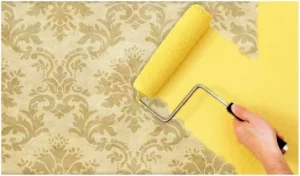
Source Pinterest
Wallpaper with a smooth surface or a pattern that is not too noticeable is simpler to conceal. Before proceeding further, it is recommended that you test a small area first. If you need clarification about anything, it is best to seek the guidance of an expert.
When looking for a temporary solution to spruce up a place, this option is both practical and economical. When painting over wallpaper, it is important to remember that preparation and using high-quality products are essential to achieving good results.
How do you Paint Over Wallpaper?
The best way to learn how to paint over wallpaper is to follow these guidelines.
Step 1: Clean the Walls
Use a cloth that is only slightly damp to remove the dust and grime off the walls. A layer of dust will prevent the primer from adhering properly. A TSP solution that has been diluted should be used to clean the walls if they are greasy and dirty.
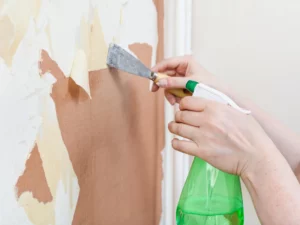
Source Pinterest
Refrain from thoroughly saturating the walls with the water or solution because doing so may cause the glue that holds the wallpaper to the wall to become softer, resulting in the wallpaper becoming loose or bubbling. Allow the walls to dry for a sufficient amount of time.
Step 2: Fix Any Holes or Tears in the Wallpaper
Keep an eye out for edges or seams that are peeling, as these are the regions that have the least amount of adhesion. When it comes to reattaching these loose parts, a few authorities suggest applying a very thin layer of wallpaper seam adhesive.
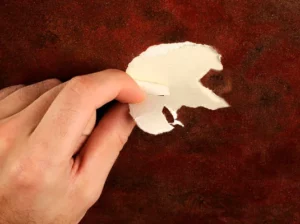
Source Pinterest
Additional advice is to use a tiny putty knife to raise those places, cut away the loose portions, fill in the gaps with Spackle to produce a level surface, and then lightly sand the area once it has had sufficient time to dry.
If the wallpaper has a texture you do not want to be visible through the paint, the entire wall must be sanded until it is smooth. You can use either a palm sander or an orbital sander for this. Dust can be removed with a cloth that has been gently dampened.
Step 3: Tape Off the Trim and Molding
Tape off any molding, trim, wainscot, or baseboard that you wish to avoid getting paint on using painter’s tape. Do this carefully.
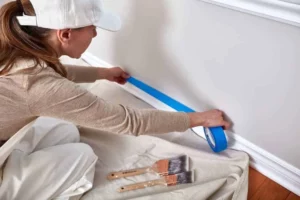
Source Pinterest
Step 4: Prepare the Wall Surfaces
You should always apply an oil-based primer before applying a topcoat, regardless of whether that topcoat will be oil-based or water-based. A primer made with water could potentially absorb into the wallpaper and cause the adhesive to become less secure.

Source Pinterest
That will not be accomplished with an oil-based primer. In the same way as you would when painting, start using a brush to fill in the edges and corners, and then switch to a roller to finish the larger stretches.
Allow the item to dry completely, following the instructions provided by the manufacturer. Check to see that there is adequate air circulation throughout the room.
Step 5: Start Painting
Paint the wallpaper in the same manner as you would paint any other surface after first cleaning, repairing, and priming it.
It will be especially important if the wallpaper has a quite noticeable pattern or if you are going to paint over dark-colored wallpaper with lighter-colored paint.
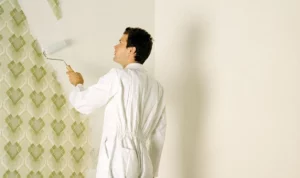
Source Pinterest
You should apply two coats, allowing ample time for each coat to dry between applications. Painting over wallpaper is a viable option, and depending on the circumstances, it may be preferable to remove the wallpaper altogether.

